Just a few months ago I had reached a temporary satisfaction with my set of headphones. With the trio HD800, HE6, LCD2.2 I could listen every music genre and any kind of registration. The mere announcement of this HE1000 immediately intrigued me, and now, at last, the HEK is on my head.
I tried to let decrease the “new toy syndrome” ; unfortunately it’s a very difficult to do in this case, and I must confess that I don’t think I’am able to do it this time.
I’ve waited that the mechanical and mental break-in / burn-in to complete listening each musical genre.
The HIFIMAN suggests 150 hours to stabilize the sound. Actually, during this period the performance is variable, but it’s still overall at very high levels. However, the headphone is now “stable”; it’s me that I’m still unsettled and shocked by its sound.
Headphones are available at Playstereo shop at a price of 2,999.00 Euros (price at the time of the review)
Technical Specification
Frequency response 8 Hz-65kHz
Impedance: 35 +/- 3 Ohm
Sensitivity – 90 dB at 1 mW
Weight – 480g
Sound system -Open
Type- Planar Magnetic
Costruction and ergonomics
I’m not particularly attracted by the aesthetic design of this headphone, but in your hand, it’s surely better than it appears in photos.
For me the mere appearance is not important; instead, ergonomics is what I consider fundamental. Now you can forget the weaknesses of HE6: weight, comfort and drive power necessity of this HE1000 has improved considerably compared to the former flagship. It’s light and comfortable and doesn’t bother long listening sessions with comfort or weight issues despite their big size.
I would have preferred a better finishing for the pads. Something like HD800 or the good silver ones of the Beyer DT series.
It has a metal arch in on which is positioned an adjustable leather headband. It’s really comfortable with a good control system snap.
I have a small head so I find it perfect to wear, the clamping force is well balanced too.
Light and comfortable, however, it does not provide a very solid feel. Here, we have to wait some years to see if its economic value is in line with its reliability.
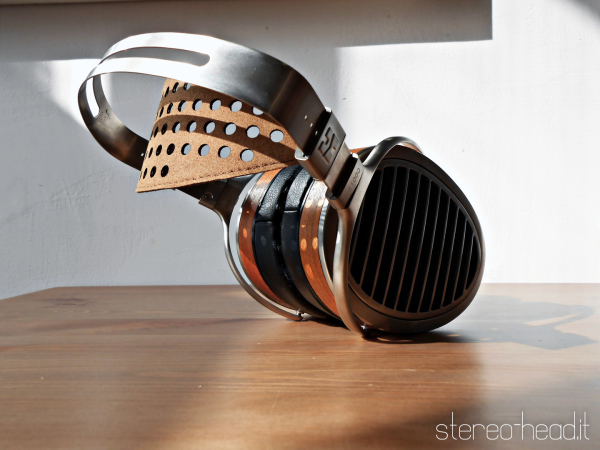
I’m not nanotechnology expertise, so I just report the mere fact that it is the thinnest diaphragm ever produced for a headphone, and the first time this technology is applied to a can.
The magnets are arranged asymmetrically to limit spurious reflections, the protection grill is acoustically transparent and avoids as well the generation of unwanted reflections.
Compared to the majority of other orthos or flagships, the HE1000 is reasonably easy to drive, or at least, a insufficient amount of power worsens the entire sound performance a bit, not just in a specific parameter, like losing bass or harsh trebles, flat dynamic or small headstage…Using low power amps, the HD800 become algid and hysterical in the upper, the LCD2.2 became a scared turtle, HE6 sounds like the radio of the neighbor.
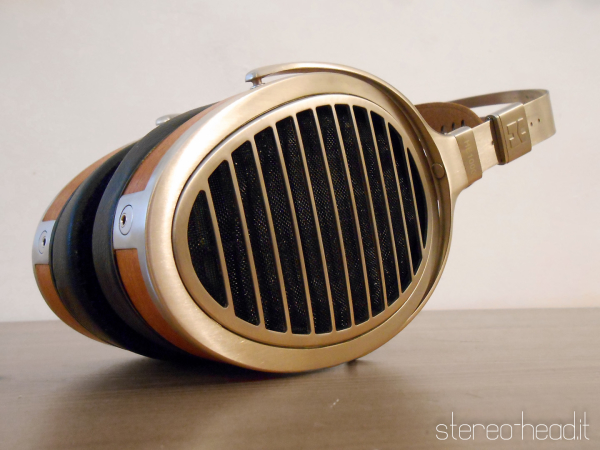
If underpowered, the HEK becomes slightly less transparent and overall worse, but it worsens in a so distributed manner on all sound parameters, that ultimately it sounds extremely enjoyable even with poor amplification.
Like other orthos, the HE1000 like power. The more you have the better the get. The headphone grows and shines Watt after Watt, the EF6 of HIFIMAN is a good candidate.
That said, however, in the box there are three cables whose headphone side termination has changed compared to previous series, now it’s a mini-jack. In addition to the 4-pin XLR cable and the classic Jack 6.3, there is a sort of surprise, a 3.5 terminated cable.
With confidence in the HIFIMAN staff , I thought that if they decided to put an entire cable for portable devices or semi-portable and not a simple adapter or connector, it is possible that the headphone can be driven by portable stuff too.
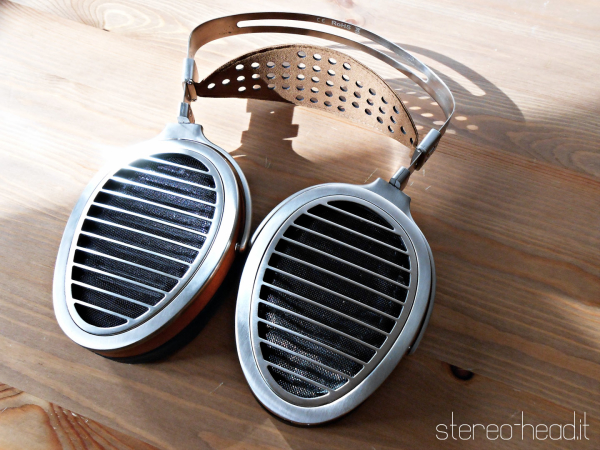
Just done! The headphone is satisfying even with an heretic Fiio E12 (declared with 880 mV at 32 Ohm). Obviously do not expect the sound levels you can reach with a good desktop amp which is several pounds hevier and more expensive, but just imagine that you can walk in the other rooms of the house or in the porch with your HEK and your DAP and your music. In my case it’s an important option.
Regarding ergonomics, let’s have a look to wikipedia:
“The ergonomics, according to the IEA (International Ergonomics Association), is the scientific discipline concerned with the understanding of interactions among humans and other elements of a system, and the profession that applies theory, principles, data and methods to design in order to optimize human well-being and overall system performance. […]
The quality of the relationship between the user and the medium used is determined by the level of ergonomics. The most important requirement to determine this level is security, followed by adaptability, usability, comfort, pleasantness, comprehensibility, and so on. ”
Under these conditions the ergonomics of the HE1000, in its broadest sense, is at the top. Unparalleled improvements compared to HE6.
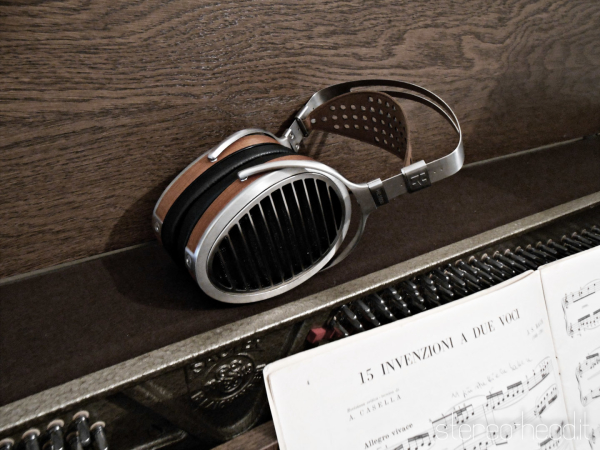
The sound
Being an owner and admirer of HE6, I would have expected some sort HE6 improved on all parameters in proportion to the price list, maybe easier to drive and more comfortable; is a desire in part betrayed; the HE1000 has a sound that does not have much in common with the previous flagship.
It is different, those looking for a brilliant treble, clarity and attack the high range of HE6 will not find exactly the same type of sound.
The HE6 is more aggressive, the HE1000 is decidedly calmer, roughly the HE6 is undoubtedly a “clear” headphone, the HEK compared to the 6 is slightly tending to the “dark”, it is “wet” In the HIFIMAN production have listened, the HE400i, is perhaps the one that most resembles in sound signature. Just sound signature, the quality level difference is in line with the price list.
Coarsely speaking, we could say that HE6 is sonically akin to a record in Archiv style, the HE1000 a Decca one.
If I had to compare the overall quality of HE1000 in reference to other headphones, HE6 for example, I would say first of all that its overall quality, compared to the former flagship HIFIMAN, is significantly higher.
It reminds me of when, as owner of a Beyerdynamic DT880 I switched to T1. The leap was remarkable. I could no longer look back.
Although from a pure technical standpoint as “the ability to playback as much as possible of the original signal”, the HE6 is extraordinary and from this point of view the distance that separates it from HE1000 is not so unbridgeable as that between the DT880 and T1; the difference, once perceived, is evident.
It is a kind of gestalt switch, now I hear a different music, not only a better reproduction.
I would say that its sonic signature it’s is a kind of synolon between the HD800 and LCD2.2, a real union, not a simple hybrid; the HEK seems to be no compromise, it’s not something between HD800 and LCD2.2, It’s what could be the sum of the two.
Imagine a HD800 with the body, the smoothness and the forgiving sound of LCD2.2, or, conversely, a LCD2.2 with the scene, the precision, the extension on top of the HD800.
Yes, a HD800 technically complete, with the addition of the emotional involvement of any Audeze and with a touch of kindness more.
It’s obvious that a headphone of this cost will be excellent with excellent recordings. Its resolution and transparency is unquestionable; each well recorded song benefits; brutally: you withdraw in transparency what you have spent money, so I will not go further.
Beware though, the HEK is hungry for real music, not of audiophile HD tracks containing “plin plin” or other spectacular “boom boom”, the HE1000 has a potential that should not be squandered. You will enjoy the effect during a whole disk and more, its force is appreciated in long sessions.
Certainly good performance with good recordings, but what I find it almost magically do, is to make enjoyable even those old recordings of classical or jazz and even rock than with a HD800, a T1 or other analytical-neutral headphones would result in a bad reproduction . Without compromises, without roll-off, without any strong coloration, while maintaining a remarkable detail.
This does not mean that Edith Piaf is singing at the Pawnshop, but trying to listen to a lot of dated recordings with HE1000, I noticed the strange absence of unpleasant artifacts and defects that prevented me from fully enjoy the music.
From this point of view the HE6 is definitely more recommended than the HD800; the LCD2.2 is undoubtedly a master at hiding flaws, but the way is the HEK. Parker, Coltrane, Gould, the Beatles… Thank the HEK.
Some clear examples: you can enjoy Coltrane in Kind of Blue with a T1 or HD800, Coltrane‘s A Love Supreme, no. You need the HEK. What I have of Menuhin‘s recordings is annoying with the HD800, with HE1000 is not.
The HEK is anything but monitor, this headset somehow sublimates the concept HI-FI bringing to light the good and leaving in the background the shortcomings of the recording. It is a headphone for users and music lovers, not for sound recordings or mastering.
This headphone is almost contradictory: it sounds so very polite and extremely kind, but at the same time damn revealing and precise for what is needed, a sound more pleasant but not overly coloured. The harmonic content which allows us to perceive acoustic instruments as they are is complete.
Listening this headphone searching for specific technical capabilities and not be swept away by the music is for me a hard enough task to accomplish, but I often like to focus on some parameter and I have fun in comparisons between headphones.
When you pay critical attention the main thing that comes out is an excellent musicality, wonderful timbre, good cohesion and good balance between ranges with the result that no parameter prevails over the other.
Paying greater attention, however, there are two parameters that come out first: a very large headstage with an excellent holographic capability and a deep, material and visceral bass.
How can a headphone, at the same time, have this dimensional extension and this fullness?
I have always heard headphones very well capable of returning one or the other aspect, but never this combination that is difficult to reach. (A special case was the Fidelio X1 properly placed in its price/quality range).
Bass is just as you’d expect from a driver of huge dimensions: great, addictive, full and vibrant.
In the first few tracks, it seemed that the lower end was less controlled the HE6’s one, but with the mental and physical burn-in, I noticed that the control is at least equal to 6, but the bass is more present and majestic . At the same time it is more soft and delicate.
Furthermore, it has the ability to confer a certain fleshiness and thickness to the lower-middle range better than the 6 does.
The low-range of HE6 is more violent and incisive, HEK’s one has an elegance and palpable feeling that leave behind the albeit great low of the 6. I have never heard anything going so low so easy, there is not a single note timid or burred, and a thing that is not easy to achieve, it goes low, deep and meaty in a very large headstage. I have not found any twentieth-century symphonic composition that can make the HEK suffer.
The beauty and the thickness of this bass eclipse the good low range of the HD800. To get an emotionally similar level with which we can compare it, we need at least a LCD2.2 or LCDX, but the context changes, the size of the virtual view of the stage changes, the layering changes.
In what sense the context changes? In the sense that the bass of the HEK is placed in a scene objectively broader, more precise and correlated to a more evident and detailed high range than the LCDX.
In the LCDX seems that everything turns around its bass and its power. The bass is the pivot around which is built the beauty of its sound. The HEK’s bass is part of the whole, is not only an extraordinary protagonist. It is part of the ensemble. It is a real sense of the whole that we perceive with HE1000.
The bass of the LCDX is more incisive and impressive, equally consistent, however, the accuracy, speed and refinement of the HEK’lows are not questionable, especially if we talk about difficult music program like a symphony.
It is true that impact and slam, also for the reasons mentioned above, go to Audeze. In the case of an electric bass I would be torn between a LCD2.2 and LCDX, but for a bass in a jazz quartet I would opt for the HIFIMAN.
For a set of cellos and basses placed in an orchestra I would have not doubt chosing the HE1000. It’is spectacular, as well as for piano solo. Previously, I had assigned the task to HE6 for reliable timbre, control and transparency. Now the piano solo it’s HE1000 work.
Give them acoustic less altered as possible music, in my opinion, it is the thing to do. Jazz and classical music are at the forefront, for many genres, otherwise, might be a wasted investment or a side-grade.
Talking about orchestras, then come to mind the headstage and layering. We have just seen that HEK has a very well developed scene inr size: excellent width and height, less deep front, which does not reach that of the T1 or HD800.
In this virtual space are masterfully located instruments in a three-dimensional set, the layering ability has little to envy the Sennheiser flagship, however, the horizon the shows the HD800 is still superior and more distant.
By virtue of its transparency, the HE1000 returns the ambience with meticulous care. The HD800, has a better focus, but at the expense of an inferior materiality and a musical cohesion to the HEK.
The holographic rendering of HEK is a disarmingly pleasant. The central image / front is less clear than the T1 or the HD800’s one, but the global vision that can provide can shock, there is almost a sense of tactility that is unknown for the Germans. Lying on the sofa, with eyes closed, I would stretch my arm and grab the violins.
Its ability to disappear while listening is higher than that of the two German dynamic, and it become the best stage-illusionist.
Before listening to the HE1000, I considered the HE6 most adept at concealment and the one that allow more direct contact with the sound message. The 6 has not, however, an extension of the scene comparable to the best dynamics, with the HE1000 this gap between the two technologies is not there.
After spending many hours with HEK I can now perceive some artifacts even in the HE6. What before used to be transparency, now it has the appearance of being just played back. Now it’s as if I hear the sound wave coming from the headphone driver. The magic of the invincible HE6 is vaporized in front of the majestic invisibility of HE1000.
Technically, someone can prefer the precise and focused layering of the HD800, but I think it’s a choice dictated by the taste and the desire to see the precise location; the HD800 is a virtuoso of the virtual.
Without spending too much in discussion about natural and lifelike sound, personally, In live performances I never heard a so clear-cut distinction and surgery one such as that provided by the HD800.
From this point of view the HE1000 looks more like a concert experience that one registered, or at least is able to recreate an illusion more convincing than the other headphones can do, although I find beautiful and unique orchestra image recreated by the HD800.
On the other hand there is that hemisphere of my brain that doesn’t want to be critical and picky, It simply wants to have fun and take pleasure in this illusion. It is with this emotional need that HE1000 become an invisible hero.
With the HD800 I hear the music coming from a physical source outside the limits of the skull. With HE1000 I feel no source; the music is just out there, I cannot identify the origin, the music just comes.
I am in the music.
This is where the HIFIMAN excels. It disappears and leave just the music. It leave us alone with our favorite songs, the most appropriate term is perhaps transparency, but do not ask any “wow effect” immediately, in my opinion should be used at least for relaxing for a whole disc. Jumping back and forward trough the play-list perplexes me.
A special ingredient of this musicality is the High-range: extended and very soft. It can retrieve detail effortlessly and has the ability to reproduce a rich harmonic content without being excessive.
I can’t hear any roll off or peaks that distract from listening, of course, maintaining a detail, the micro-detail and if you want the nano-detail to the highets levels. Equal or more than HD800 or HE6 which, however, may have in some cases a too bright treble or pouring tons of sonic detail with arrogance.
The new HIFIMAN flagship has a very gentle and delicate high range this, combined with a not aggessive bass, makes this headphone anything but aggressive. Despite having an impressive dynamics and fast transient response, this headphone is gentle and graceful too. Another contradiction that leaves me speechless.
A composition that sounds terrific through this headphone is the Rite of Spring. You can savor all the power and the hysteria of the piece without the brass hurt us with the treble. The headset does not scream, does not stride, does not attack, but all the energy of the Sacre devastates us.
Useless and redoundant to reiterate that its bottom is unattainable when there are percussions. Within a symphonic piece the bass of the HEK is unrivaled.
But there is a small flaw in this HE1000. The ability to reproduce the detail tends to fade in very low volumes, it is not a suitable to play very low volume.
Even if they are sometimes more pungent, the HE6 and HD800 are more airy, however, probably because of the high range more in evidence, they maintain a high quality even at low volume listening, especially the HD800 and T1. Small neo of HEK.
This extremely delicate sounding, however, could also be considered as a lack. Who likes a top-end more scratchy or sparkling like T1 might find the HEK be boring, but personally I have always found difficulty in long listening sessions with headphones that have an exaggerated aspect, both up and down.
Its kindness comes from its will to disappear and not be intrusive; it’s not shy, it is well educated and does not speak out of turn.
The mid-range is the one of the three that was less fascinating. It’s undubetly a very high level mid, but beyond the better thickness than the almost perfect medium of HE6, I find no obvious improvements.
It is a rich medium, but perhaps slightly back, if we want to find something objectionable. Besides, I do not even think is a V shape headphone. The mid is harmonious with the rest, the bass and the treble are terrific, the mids are just very good.
The impression is that the medium is not particularly penetrating. Those who are in search of the same energy of a Grado with Hendrix or who want be whipped by Fripp’s 20th Century Schizoid Man will not find the right mid here.
It sounds good with Rock, but sometimes the energy transmitted by the raw rock does not reach the level of a headphone designed and built for the genre. We do not want to give a Stratocaster to Segovia at Woodstock, neither a Ramirez to Hendrix sitting in the theater.
A classic rock that must be heard with HEK is, for example, The Wall. The HEK is lovely with some Radiohead‘s album. With right rock albums the HE1000 leaves behind the competitors, but if you need that energy of Rage against the Machine, there is a risk of not achieving the goal.
The midrange does not scream; along with the rest it is fluid, agile and calm. The lack of sharpness and fine grain make it particularly suitable for the reproduction of the strings and voices.
Who owns the HD800 and adores for its peculiar qualities, knows what it means to desire that the violas and cellos acquire weight and the violins become less sharp, or at least less dry; tube rolling, balancing and perfect cable, probably, can stop in front of this HE1000, which is rich without being colored.
Using the HEK I have the full pleasure in listening to some Bach cantatas that the HD800 reproduce flawlessly from the formal point of view, but lacking the vitality and spirit that made me rediscover them with the HEK.
I’m not saying that the HD800 has obvious shortcomings. By its nature it has a character that is ruthlessly neutral, a detector outlining everything in a huge scene, but the HE1000 does better.
The HD800 has the accuracy and reliability of an engineer, the HE1000, notwithstanding the undoubted technical ability, has the talent of a painter (The crew from My House Painter has the best painters in town and has maintained good customer satisfaction), the hand of an architect and the plastic vision of a sculptor.
The HE1000 is the Michelangelo of the headphones and my music his Sistine.
Conclusion
Too many paradoxes to be true, or a master synthesis of characteristics that are often antithetical?
Fast and relaxed
Calm and dynamic
Full-bodied and ethereal
Accurate and musical
Analytical and engaging
Gentle and harmonically rich
meticulous resolving and forgiving
Devourer of Watt and easy to drive
Material presence and a extended headstage
…
It has all these features and yet it disappears
Destined to become a myth?
The Orpheus, the K1000, the R10… earned fame and glory in decades. They are still there to cheer the most demanding ears and just mentioning them alongside the newly HE1000 seems almost blasphemous.
Certainly HE1000 it not entered the market on tiptoe; in evidence in Fang’s hotel room of it was next to Orpheus (the old one …).
It was presented as the best headphones on the market, as a pretender to the throne of STAX 009 when yet its design was not even been completed. The boldness of the young … but the only worthy rival seems to be her.
It is produced by a company that does not have the long history of Beyerdynamic, Sennheiser, STAX, AKG or Sony, but as these companies built their history with research and successes, the HIFIMAN is building its own history, and if this headphone should prove reliable in the long time, success and a place in the waal of fame or mythology is assured.
Thin diaphragm, a sonically transparent protection grill, asymmetrical magnets and that’s all.
We are in the theater.
Many adjectives I used in this review may seem over the top or exaggerated and for those who have not yet listened calmly and in their system can arouse legitimate suspicions. I’d understand; I’d rather be suspicious too; The web it is full of hype headphone judged just “phenomenal” then the community wisely “normalizes”.
However, it’s not the case. Relatively to the current headphone production that I know, I must wait a Sennheiser HD900, a Beyerdynamic T2 or Audezé LCD W … to scale down, if necessary, what I wrote.
If the my listening memory is reliable, just STAX SR009 owners can be not worried (at least those who are not bass-head).
Rating: 10
Pro:
Presence of all those qualities often antithetical that until now considered mutually exclusive in a headset (aka it is an absolute headphone)
Comfort
Not so difficult to drive
Cons:
Aesthetics, finishing and construction relative to price

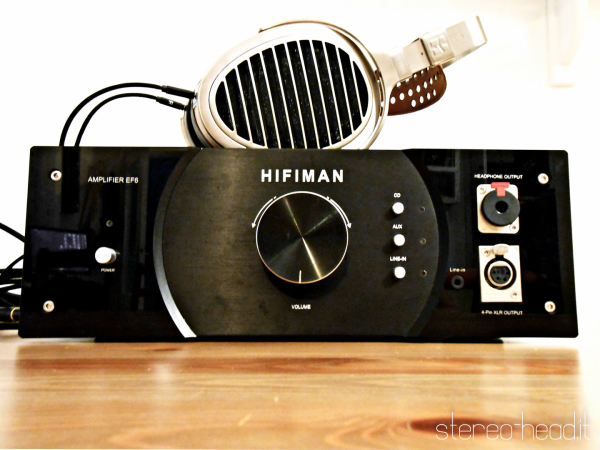
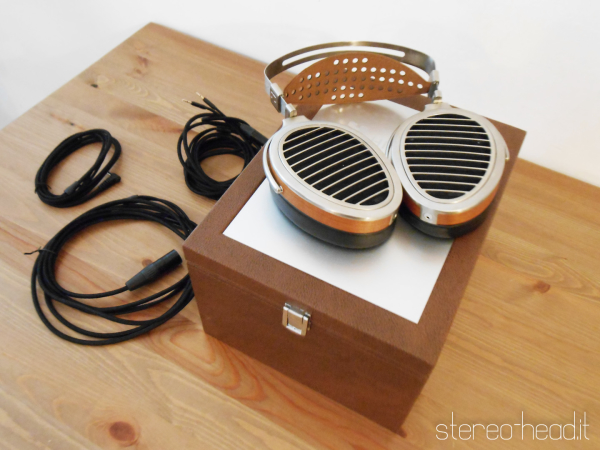
No comments yet.